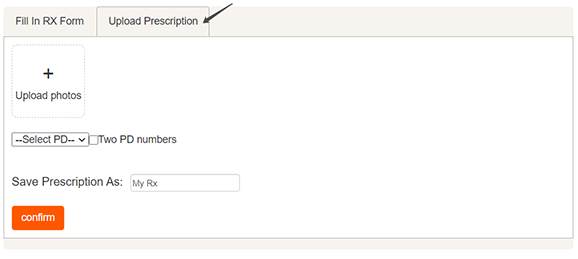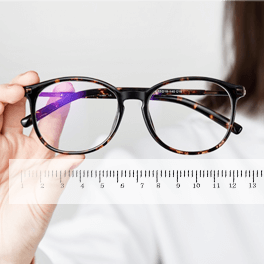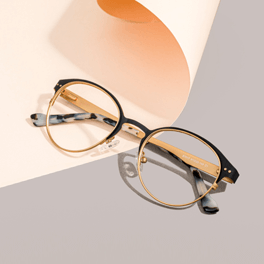FAQ
Quick Links
Prescription (RX)
An eyeglass prescription or RX issued by an eyeglass prescriber after an eye examination is necessary when buying prescription glasses.
Eyeglass prescriptions vary but typically include the patient's name, power of the lenses, prism, pupillary distance, expiration date, and the prescriber's signature.
To read or understand an eyeglass prescription can get complicated if you don't know optical knowledge and the abbreviations well.
*Click here to get the guide of how to read prescription.
To get your glasses prescription, you need to make an appointment with your eye care provider or local vision center for an eye exam, and they will issue it for you.
Don't forget to double-check if there's a PD measurement on your prescription.
*Click here to know how to measure your PD.
No, contact lens prescriptions usually get a weaker strength for the lens (because they are closer to your eyes), which cannot be used for eyeglasses purchasing.
Reading an eyeglass prescription can be tricky work to do. To get you a pleasant and easy online shopping at Zinff, we provide a prescription help service. You can upload your prescription photo and select your PD number when ordering the glasses. We will read your prescription once we receive your order information.
*Click here to find out your PD measurement.

If you are interested in decoding your eyeglass prescription, here are some optical abbreviations that you should know first.
Additionally, prescriptions vary in different languages or writing formats. If you cannot understand that, we recommend uploading your prescription, and we will read it for you.
*If you have a prism prescription, please upload it to your order in case of any production faults.
OD, OS, OU
OD refers to Oculus Dexter, which is a Latin term for the right eye.
OS represents Oculus Sinister, which is a Latin term for the left eye.
OU refers to Oculus Uterque, which means both eyes.
On an eyeglasses prescription, your right eye (OD) always comes before the information for your left eye (OS). Eye doctors write prescriptions this way.
Sphere/Spherical (SPH)
It indicates the value of lens power prescribed to correct nearsightedness or farsightedness. If the numbers in this section appear with a minus sign (-), it means you are nearsighted; if it has a plus sign (+), then you are farsighted.
These signs are essential when you fill in the RX form, so make sure you select the correct numbers. Most values will be 0.00 to +/-10.00.
Several abbreviations under this heading mean no power for nearsightedness or farsightedness.
1.The SPH field is blank.
2.There is a "PLANO/PL", "INFINITY/∞", "NONE/00", "SPH", "DS", "BALANCE/BAL" in SPH field.
Cylinder/Cylindrical (CYL)
It indicates the amount of lens power for astigmatism. The power of value appears with a plus or a minus sign in most cases and will be between +/-0.25 to +/-4.00.
Several abbreviations under this heading mean no power for astigmatism.
1.The CYL field is blank.
2.There is a "PLANO/PL", "INFINITY/∞", "NONE/00", "SPH", "DS", "BALANCE/BAL" in CYL field.
Axis
This value will be appearing as a degree number from 1 to 180. The numbers only describe the position of astigmatism, so an Axis cannot be present if there is no CYL value.
PD
PD stands for Pupillary Distance measured in millimeters. It is the distance between the centers of your pupils. This measurement is necessary for glasses production, so make sure you measure it as accurately as possible.
*Click here to know how to measure your PD.
Addition (ADD/NV/near)
It stands for the additional magnifying power applied to correct presbyopia (people who are over 40 years old may get it). The number under this heading always has a plus sign, even if there is no plus sign. Generally, it will be the same power for both eyes and range from +1.00 to +3.00.
Prescription Examples:
Prescription in English looks like this.

Prescriptions in other languages look like these.

*ESFERA is Sphere, CILINDRO is Cylinder, EJE is Axis, ADICIÓN is ADD, DP is PD.
The ADD—short for Reading Addition—is the additional correction required for reading. It can be used to make either reading glasses, bifocal glasses or multifocal glasses. If you wish to choose bifocal/progressive lenses, the ADD number should be included in your prescription.
The "addition" is only required if the glasses are going to be used for reading or close work. Please kindly note that if you have ADD and choose distance glasses, the glasses can only be used for seeing far, not available for reading. Sometimes opticians use the word "Add" or "Near" instead of "addition". They may only write it once, but it normally applies to both eyes and is almost always the same value for both eyes (e.g. 'Add' +2.50 - should be entered for both eyes).
Here is a reference:
| Age | Add Power |
| 35-39 | Plano |
| 40-44 | +1.00 |
| 45-49 | +1.50 |
| 50-54 | +2.00 |
| 55-59 | +2.50 |
| 60-64 | +3.00 |
Yes. Every detailed information on your eyeglasses prescription matters. So make sure that you read it carefully and input it correctly on the site. If you cannot read the prescription, feel free to ask our customer service department for help.
Yes, no problem! Most eyeglasses online retailers ask you to read your prescription yourself, but at Zinff we are pleased to assist you with it. You only need to upload your prescription when placing the order. We will read it for you right after we receive your order information.
For nearsighted people, the distant objects are blurry, while near objects appear clearly. The prescriptions for nearsighted people have negative values in the SPH field.
For farsighted people, the distant objects appear clearly, while near objects are blurry. The prescriptions for farsighted people have positive values in the SPH field.
Presbyopia is an age-related condition in which the lens of the eye becomes less flexible. So most people do not notice any significant problems until they are 40 to 50 years old. The prescriptions for presbyopia have positive values in the ADD field.
*Click here for more information about reading an eyeglasses prescription.
People with severe astigmatism usually have blurred or distorted vision at all distances, while people with mild astigmatism may experience eye strain, headaches, or blurred vision at certain distances.
Prescriptions for astigmatism correction should contain positive or negative values in the CYL field and degree numbers from 1 to 180 in the Axis field.
Distance vision refers to eyesight for tasks beyond arm's length, tested at a distance of approximately 20 feet.
Intermediate vision refers to eyesight for tasks at 20 inches (50 cm), usually used for computer work.
Near vision refers to eyesight used for up close, like reading, generally at a range of 11 to 16 inches (27-40 cm) from the eyes.
Yes. Our optical lab can process prism prescription. All you need to do is uploading your prism prescription to your order when you are filling in the RX form. Our customer service department will reach out to you for more information once you place the order.
Yes, we offer high-quality bifocals and progressives. You can choose the glasses type you need after you select the frame you like.
Yes, you can order prescription sunglasses from our Sunglasses Collection. There are many chic frames and lens colors that you can choose from.
Yes, of course. Click the "Non-Prescription" button when selecting the lenses, and you can get your non-prescription glasses.
Sorry, we don't offer this kind of service. It's also unsafe doing so because the lenses may be easily broken in transit.
We can change your order details for free if your order is still in "Paid" status and hasn't been updated to "Product Manufacturing". Please note that any price differences of frame, lens, coating, and shipping upgrades will be charged.
If the order status is "Product Manufacturing", it means your order is in the process now. Our optical lab and lens supplier will charge a processing fee for the changes. If your lenses are free, a 5.00 USD processing fee is needed. If you have upgraded lenses or coatings, then half of the lens total will be charged.
If the order has already been packaged and shipped out, we cannot change the order details for you.
For negative SPH power, we can process a prescription range from -0.25 to -18.00.
For positive SPH power, we can process a prescription range from +0.25 to +10.00.
For CYL power, we can process a range from 0.00 to +4.50 and 0.00 to -4.50.
For ADD power, we can process a range from +1.00 to +3.50.
For the other prescriptions beyond these ranges of the power, please contact our customer service for more information (including prism correction, high cylinder prescription).
Yes. The expiration of an eyeglasses prescription is generally two years, which means you have to take an eye exam every two years. If there's any change in your new prescription, don't forget to buy a new pair to correct your eyesight in case it gets worse.
If you have had your old glasses for years and often feel eye strain or headaches, then you should think of buying a new pair with a new prescription. Additionally, it is a good idea to get your eyes tested every two years.
Prescriptions change overtime. If you are wearing an outdated prescription, you may be experiencing unnecessary eye strain.
Eye doctors will write the expiration date down on your prescription. Eyeglasses prescription expiration periods vary but are usually one to two years.
Your eyeglass prescription will be registered at any eye care provider or vision center where you have had an eye exam. If you accidentally lose your prescription, you can request a copy of the prescription at least one year after you take the eye exam.
In most instances, you will be given a copy of your eyeglasses or contact prescription after the exam, but if you are not, you can always request one.
It is a legal requirement to provide you with your eyeglasses prescription or prescription for contact lenses upon request.
Also, be aware that your prescription for glasses is completely separate and different from your contacts prescription, so you will need individual exams to obtain a prescription for each.










